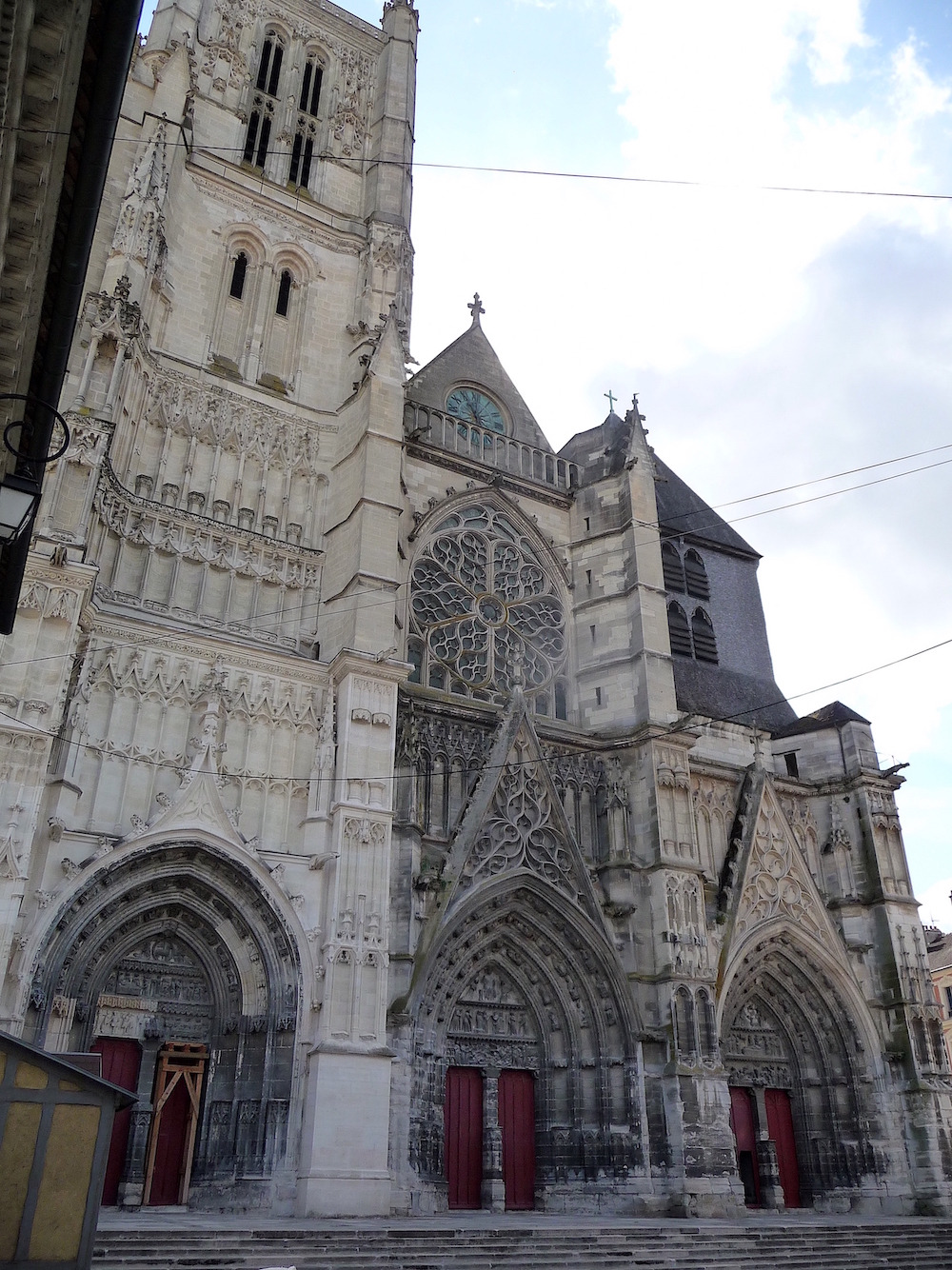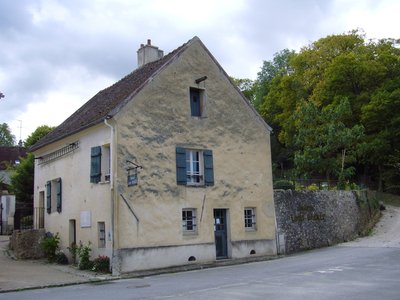Lagny-sur-Marne to Meaux

Île-de-France
13. Lagny-sur-Marne to Meaux
Medium
5h30
20,9km
+187m
-182m
Step
Embed this item to access it offline
From the remains of the Abbey of Saint-Pierre in Lagny-sur-Marne, founded by the Irish monk Saint Furzy, to the episcopal headquarters of the Aigle de Meaux, you will follow the course of the waterways that carried passengers and goods to the capital along the locks, discovering the milled architecture of the "panicky" villas on the banks of the Marne and the administrative buildings, a strange sculpture garden, a castle soon specialised in glass work...
3 points of interest

La façade de l’église Saint-Furzy ayant survécu à la démolition à Lagny-sur-Marne - Association Colomban en Brie TouristThe Saint-Pierre de Lagny-sur-Marne
The Saint-Pierre de Lagny-sur-Marne monastery was founded by Saint Fursy (Fursey - Fursa - Forseus) in the 7th century.
Fursy is celebrated as one of the most important of all Irish missionary monks in the 7th century with Saint Colomban.
Born in Ireland into a noble family, this visionary travelled throughout England before coming to the continent to found the monasteries of Lagny and Peronne.
He arrived in a region where Luxembourg monasticism was expanding rapidly and the royal courts welcomed the Irish monks with great kindness, on a par with Erchinoald, mayor of the Neustrie palace, who proposed to Fursy to build a monastery in Lagny-sur-Marne.
Founded around 644 the monastery received donations from Clovis II and Bathilde, ruined by the Normans in the 9th century it was rebuilt. During his consecration King Robert the Pious offered a nail of the True Cross which was lost a few centuries later.
The monastery was sold as national property in 1797 to become a hospital and then the town hall of Lagny-sur-Marne in the middle of the 19th century. The complex was classified as a historical monument in 1886 and 1969.
Today, three buildings rebuilt over the centuries bear witness to the history of this illustrious abbey founded by Saint Furzy. The town hall with the old cloister, the Saint-Furzy church and the Notre-Dame des Ardents church. In 1430, Joan of Arc came to pray in this church where she performed the miracle of the resurrection of the dead child.
More information: Wikipedia
Sculpture monumentale dans le Jardin de la Dhuys. - Association Colomban en Brie CulturalDhuys sculpture garden in Chessy
Along the Marne stretches a garden with majestic sculptures, sometimes unfinished but always full of poetry, inviting you to dream.
The site of the sculpture garden was occupied from the 1860s onwards by the Dhuis aqueduct, built to carry water from the Dhuis (or Dhuys) to the Ménilmontant reservoir in Paris.
They are carved on site by the artist Jacques Servières from the stones from the Dhuys aqueduct bridge, bombed in 1939 and left lying there, on the edge of this non-urbanized plot.
Maison natale de Louis Braille - Association Colomban en Brie CulturalLouis Braille's birthplace in Coupvray
This typical Bright House became a museum in 1956 in honour of the man born there in 1809 and invented the tactile writing to which he gave his name: Louis Braille.
A garden of the five senses completes the visit.
13 rue Louis Braille in Coupvray
Description
Departure from the Lagny sur Marne town hall square. Reach the edge of Marne by the Rue des Marchés then the Rue du Chemin de Fer. Before the bridge, turn right onto Quai Saint-Père and follow the Red and White signs with the Marne on your left. Follow the river for about 2.2km, ignoring the departures on the right and passing a leisure park, then turn right to move away from the bank.
- End on the old Meaux road then the Quincangrogne road (tarred) then the Old Meaux road. Go to the entrance of the Jardin de sculptures de la Dhuys, at a crossroads with Rue de la Marne. To the left and then to the right to cross the Garden of Sculptures, with red and white markers and the edge of the Marne. Pass lock n°14 of Chalifert, turn right, pass a barrier and second path on the right, pass in front of restaurant l'hermitage.
- Crossroads in the forest on the left, then on the right. Walk along a large house and climb, ignoring a path start on the right. Cross the Jabelines D45 road and go straight ahead. Cross the Route de Lesches D89, take a small road in front of it, going down at an angle on the left.
- Stay on your right hand side of the Meaux canal at Chalifert, go under the railway bridge and then pass lock n°13 of Lesches-Coupvray. Go along the Canal on your right. Take the bridge on de street and turn left to access the bridge and cross the canal.
- At the exit of the bridge on the left, red and white markings, and follow the canal on the left. Ignore a footbridge and go further under a railway bridge.
- Take the pedestrian and bicycle bridge parallel to the road bridge. At the exit, cross the road carefully and follow the canal on your right until you reach the next bridge and take the bridge (Rue de Condé) to take the canal bank to the left immediately. Walk past the Château de Condé.
- Cross the Grand Morin along the canal bridge, left leaving the red and white markings, take the bridge. Exit the bridge on the right and walk on a strip of land between the Marne on your left and the canal on your right.
- At the next bridge straight ahead you will find the red and white markings along the canal on your right. Pass under a motorway viaduct and reach the Mareuil-les-Meaux bridge. Cross the canal at the exit of the bridge, first path on the left to follow the canal on the left. Ignore the next metal bridge and go straight ahead.
- Turn left at the crossroads with rue Georges Renard. Ignore a start on the left. Cross rue Francois de Tessan (D360) and follow it to the left to cross lock n°12 of Meaux. Immediately turn right onto the Quai du Maréchal Mortier. Go along the lock and then the Marne after a left turn. Turn left again, along a canal, find the bridge on the D360 on the right to cross the canal.
- Exit the bridge, go down immediately to the right and follow the Quai Charles Deboeuf. Pass under the Pont Foch and follow the Marne again. Pass under the Pont Neuf and join the Pont du Marché. Borrow it to cross the Marne. Cross the Quai Victor Hugo, Rue du Grand Cerf, second street on the left, Rue du Général Leclerc you arrive in front of the Saint-Étienne Cathedral.
- Departure : Church Notre-Dame des Ardents, Place de l’hôtel de ville, 77400, Lagny-sur-Marne
- Arrival : Saint Stephen's Cathedral, Place Saint Pierre, 77100, Meaux
- Towns crossed : Île-de-France
Altimetric profile
Transport
Report a problem or an error
If you have found an error on this page or if you have noticed any problems during your hike, please report them to us here:
Close by8
- Accommodation








